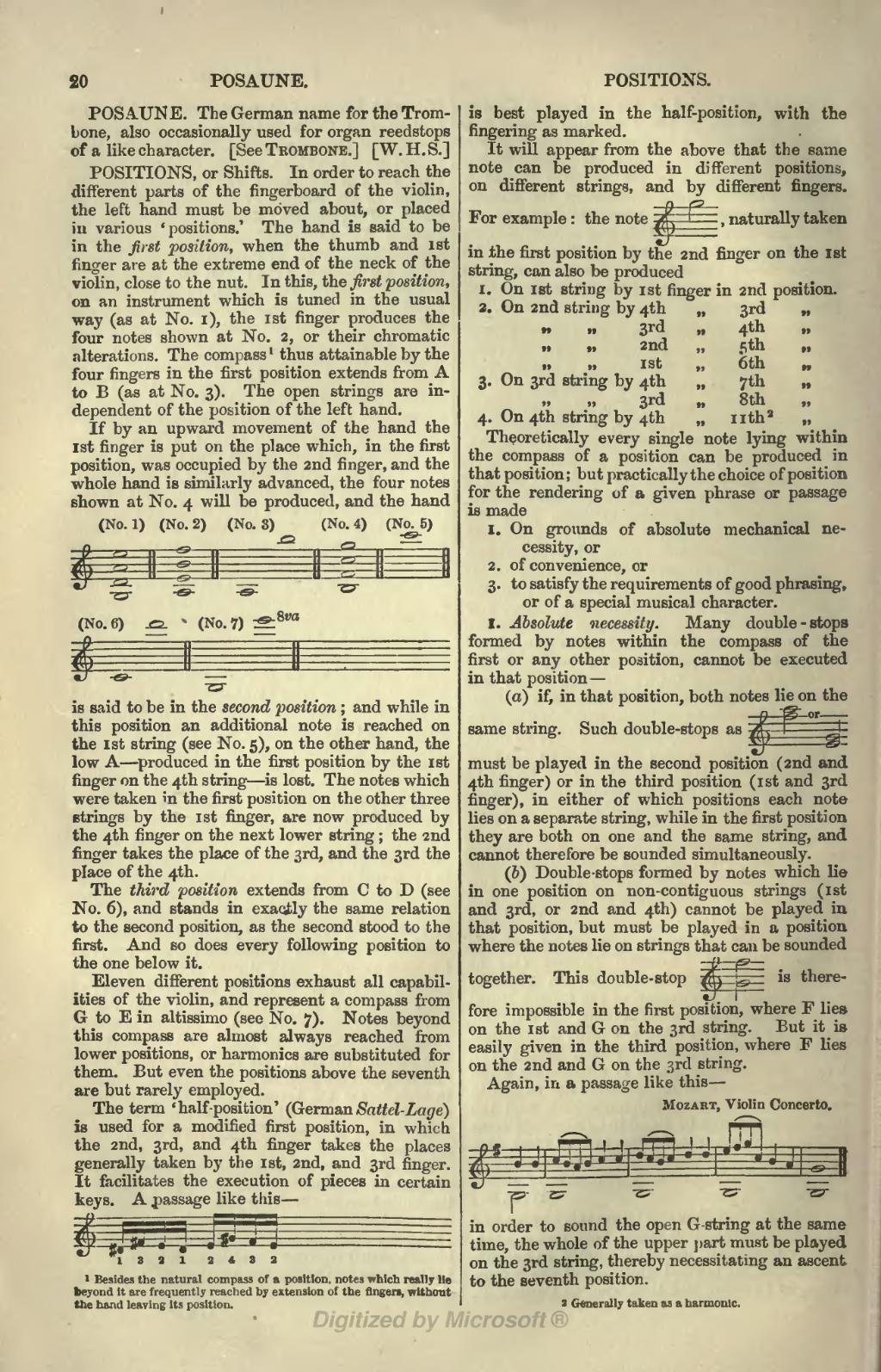POSAUNE. The German name for the Trombone, also occasionally used for organ reedstops of a like character. [See Trombone.]
POSITIONS, or Shifts. In order to reach the different parts of the fingerboard of the violin, the left hand must be moved about, or placed in various 'positions.' The hand is said to be in the first position, when the thumb and 1st finger are at the extreme end of the neck of the violin, close to the nut. In this, the first position, on an instrument which is tuned in the usual way (as at No. 1), the 1st finger produces the four notes shown at No. 2, or their chromatic alterations. The compass[1] thus attainable by the four fingers in the first position extends from A to B (as at No. 3). The open strings are independent of the position of the left hand.
If by an upward movement of the hand the 1st finger is put on the place which, in the first position, was occupied by the 2nd finger, and the whole hand is similarly advanced, the four notes shown at No. 4 will be produced, and the hand is said to be in the second position; and while in this position an additional note is reached on the 1st string (see No. 5), on the other hand, the low A—produced in the first position by the 1st finger on the 4th string—is lost. The notes which were taken in the first position on the other three strings by the 1st finger, are now produced by the 4th finger on the next lower string; the 2nd finger takes the place of the 3rd, and the 3rd the place of the 4th.

The third position extends from C to D (see No. 6), and stands in exacily the same relation to the second position, as the second stood to the first. And so does every following position to the one below it.
Eleven different positions exhaust all capabilities of the violin, and represent a compass from G to E in altissimo (see No. 7). Notes beyond this compass are almost always reached from lower positions, or harmonics are substituted for them. But even the positions above the seventh are but rarely employed.
The term 'half-position' (German Sattel-Lage) is used for a modified first position, in which the 2nd, 3rd, and 4th finger takes the places generally taken by the 1st, 2nd, and 3rd finger. It facilitates the execution of pieces in certain keys. A passage like this—
![{ \override Score.TimeSignature #'stencil = ##f \relative d' { dis16-1[ fis-3 e-2 dis-1] e-2[ gis-4 fis-3 e-2] s4 } }](http://upload.wikimedia.org/score/a/g/ag5jv6nsr7dkn1uvyjxoe7akvt8eg5i/ag5jv6ns.png)
is best played in the half-position, with the fingering as marked.
It will appear from the above that the same note can be produced in different positions, on different strings, and by different fingers.
For example: the note

, naturally taken in the first position by the 2nd finger on the 1st string, can also be produced
| 1. | On | 1st | string | by | 1st | finger in | 2nd | position. |
| 2. | On | 2nd | string | by | 4th | {{{1}}}„ | 3rd | {{{1}}}„ |
| 2nd„ | string„ | 3rd | {{{1}}}„ | 4th | {{{1}}}„ | |||
| 2nd„ | string„ | 2nd | {{{1}}}„ | 5th | {{{1}}}„ | |||
| 2nd„ | string„ | 1st | {{{1}}}„ | 6th | {{{1}}}„ | |||
| 3. | On | 3rd | string | by | 4th | {{{1}}}„ | 7th | {{{1}}}„ |
| 2nd„ | string„ | 3rd | {{{1}}}„ | 8th | {{{1}}}„ | |||
| 4. | On | 4th | string | by | 4th | {{{1}}}„ | 11th[2] | {{{1}}}„ |
Theoretically every single note lying within the compass of a position can be produced in that position; but practically the choice of position for the rendering of a given phrase or passage is made
- On grounds of absolute mechanical necessity, or
- of convenience, or
- to satisfy the requirements of good phrasing, or of a special musical character.
1. Absolute necessity. Many double-stops formed by notes within the compass of the first or any other position, cannot be executed in that position—
(a) if, in that position, both notes lie on the same string. Such double-stops as

must be played in the second position (2nd and 4th finger) or in the third position (1st and 3rd finger), in either of which positions each note lies on a separate string, while in the first position they are both on one and the same string, and cannot therefore be sounded simultaneously. (b) Double-stops formed by notes which lie in one position on non-contiguous strings (1st and 3rd, or 2nd and 4th) cannot be played in that position, but must be played in a position where the notes lie on strings that can be sounded together. This double-stop

is therefore impossible in the first position, where F lies on the ist and G on the 3rd string. But it is easily given in the third position, where F Lies on the 2nd and G on the 3rd string.
Again, in a passage like this—

in order to sound the open G-string at the same time, the whole of the upper part must be played on the 3rd string, thereby necessitating an ascent to the seventh position.
